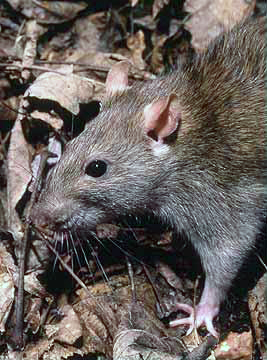
Plague is an infectious disease caused by the bacterium Yersinia pestis. Symptoms include fever, weakness and headache. Usually this begins one to seven days after exposure. There are three forms of plague, each affecting a different part of the body and causing associated symptoms. Pneumonic plague infects the lungs, causing shortness of breath, coughing and chest pain; bubonic plague affects the lymph nodes, making them swell; and septicemic plague infects the blood and can cause tissues to turn black and die.

Rats are various medium-sized, long-tailed rodents. Species of rats are found throughout the order Rodentia, but stereotypical rats are found in the genus Rattus. Other rat genera include Neotoma, Bandicota and Dipodomys.

Yersinia pestis is a gram-negative, non-motile, coccobacillus bacterium without spores that is related to both Yersinia enterocolitica and Yersinia pseudotuberculosis, the pathogen from which Y. pestis evolved and responsible for the Far East scarlet-like fever. It is a facultative anaerobic organism that can infect humans via the Oriental rat flea. It causes the disease plague, which caused the Plague of Justinian and the Black Death, the deadliest pandemic in recorded history. Plague takes three main forms: pneumonic, septicemic, and bubonic. Yersinia pestis is a parasite of its host, the rat flea, which is also a parasite of rats, hence Y. pestis is a hyperparasite.

The black rat, also known as the roof rat, ship rat, or house rat, is a common long-tailed rodent of the stereotypical rat genus Rattus, in the subfamily Murinae. It likely originated in the Indian subcontinent, but is now found worldwide.

Flea, the common name for the order Siphonaptera, includes 2,500 species of small flightless insects that live as external parasites of mammals and birds. Fleas live by ingesting the blood of their hosts. Adult fleas grow to about 3 millimetres long, are usually brown, and have bodies that are "flattened" sideways or narrow, enabling them to move through their hosts' fur or feathers. They lack wings; their hind legs are extremely well adapted for jumping. Their claws keep them from being dislodged, and their mouthparts are adapted for piercing skin and sucking blood. They can leap 50 times their body length, a feat second only to jumps made by another group of insects, the superfamily of froghoppers. Flea larvae are worm-like, with no limbs; they have chewing mouthparts and feed on organic debris left on their hosts' skin.

The third plague pandemic was a major bubonic plague pandemic that began in Yunnan, China, in 1855. This episode of bubonic plague spread to all inhabited continents, and ultimately led to more than 12 million deaths in India and China, and at least 10 million Indians were killed in British Raj India alone, making it one of the deadliest pandemics in history. According to the World Health Organization, the pandemic was considered active until 1960 when worldwide casualties dropped to 200 per year. Plague deaths have continued at a lower level for every year since.

Murine typhus, also known as endemic typhus or flea-borne typhus, is a form of typhus transmitted by fleas, usually on rats, in contrast to epidemic typhus which is usually transmitted by lice. Murine typhus is an under-recognized entity, as it is often confused with viral illnesses. Most people who are infected do not realize that they have been bitten by fleas. Historically the term "hunger-typhus" was used in accounts by British POWs in Germany at the end of World War I when they described conditions in Germany.

The Oriental rat flea, also known as the tropical rat flea or the rat flea, is a parasite of rodents, primarily of the genus Rattus, and is a primary vector for bubonic plague and murine typhus. This occurs when a flea that has fed on an infected rodent bites a human, although this flea can live on any warm blooded mammal.

The discipline of medical entomology, or public health entomology, and also veterinary entomology is focused upon insects and arthropods that impact human health. Veterinary entomology is included in this category, because many animal diseases can "jump species" and become a human health threat, for example, bovine encephalitis. Medical entomology also includes scientific research on the behavior, ecology, and epidemiology of arthropod disease vectors, and involves a tremendous outreach to the public, including local and state officials and other stake holders in the interest of public safety.

Paul-Louis Simond was a French physician, chief medical officer and biologist whose major contribution to science was his demonstration that the intermediates in the transmission of bubonic plague from rats to humans are the fleas Xenopsylla cheopis that dwell on infected rats.

Bubonic plague is one of three types of plague caused by the bacterium Yersinia pestis. One to seven days after exposure to the bacteria, flu-like symptoms develop. These symptoms include fever, headaches, and vomiting, as well as swollen and painful lymph nodes occurring in the area closest to where the bacteria entered the skin. Acral necrosis, the dark discoloration of skin, is another symptom. Occasionally, swollen lymph nodes, known as "buboes", may break open.
Theories of the Black Death are a variety of explanations that have been advanced to explain the nature and transmission of the Black Death (1347–51). A number of epidemiologists from the 1980s to the 2000s challenged the traditional view that the Black Death was caused by plague based on the type and spread of the disease. The confirmation in 2010 and 2011 that Yersinia pestis DNA was associated with a large number of plague sites has led researchers to conclude that "Finally, plague is plague."

Operation Big Itch was a U.S. entomological warfare field test using uninfected fleas to determine their coverage and survivability as a vector for biological agents. The tests were conducted at Dugway Proving Ground in 1954.
The E14 munition was a cardboard sub-munition developed by the United States biological weapons program as an anti-crop weapon. In a series of field tests in 1955, the E14 was loaded with fleas and air-dropped.
The E23 munition was a cardboard sub-munition developed by the United States biological weapons program for use as an anti-crop weapon. The E23 underwent a conversion for use as a vector weapon and was briefly used in large-scale entomological warfare trial but technical issues forced it from the tests.

Nosopsyllus fasciatus, the northern rat flea, is a species of flea found on domestic rats and house mice. Northern rat fleas are external parasites, living by hematophagy off the blood of rodents. N. fasciatus can bite humans, but they are more common parasites of rodents. Since they are associated with humans, they are common disease vectors that can spread from animals to humans. Diseases that can be spread through fleas include the plague and typhus. The rat flea is widespread due to their relationship to rodents and other vertebrates. They can be found co-infecting their host with other parasites.

Urban plague is an infectious disease among rodent species that live in close association with humans in urban areas. It is caused by the bacterium Yersinia pestis which is the same bacterium that causes bubonic and pneumonic plague in humans. Plague was first introduced into the United States in 1900 by rat–infested steamships that had sailed from affected areas, mostly from Asia. Urban plague spread from urban rats to rural rodent species, especially among prairie dogs in the western United States.

Xenopsylla brasiliensis is a species of flea found on rats. It is a vector of bubonic plague, and is found in South America, Africa, and India.

Madagascar has experienced several outbreaks of bubonic and pneumonic plague in the 21st century. In the outbreak beginning in 2014, 71 died; in 2017, 202 died. Smaller outbreaks occurred in January 2008, and December 2013.
Lieutenant Colonel William Glen Liston was a British Army doctor and medical entomologist who worked in the Indian Medical Service and was among the first experimenters to demonstrate that plague was transmitted by rat fleas and was involved in developing a plague vaccine.














